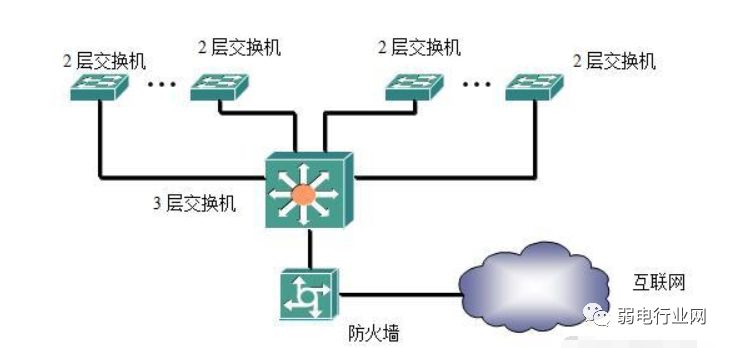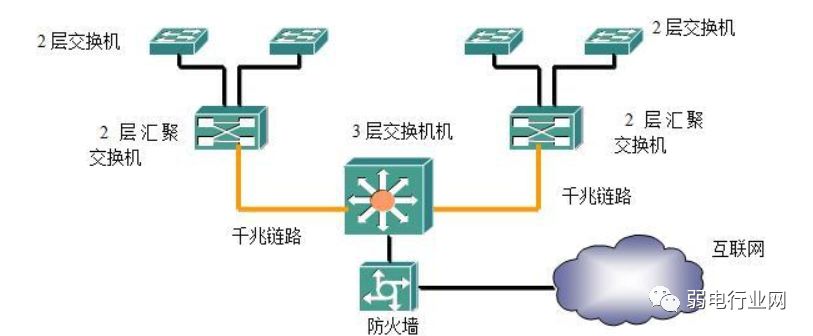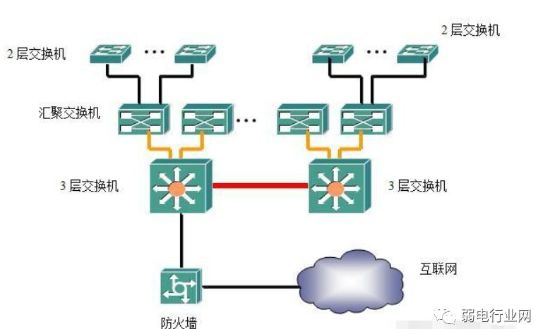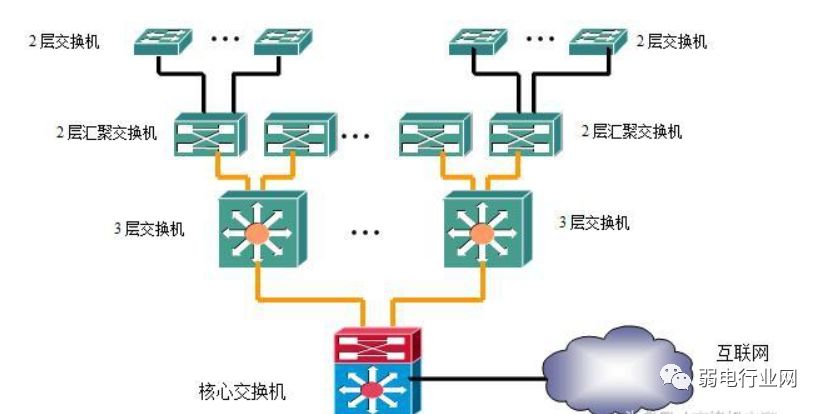Today, let’s take a look at the four networking methods for switches, which is an enhanced version of the article from two days ago.
1. Small Network
For around 100 connected users, this is considered a small to medium-sized enterprise network. This raises a question that many friends have asked: Do you need a core switch for 100 connections?
Basically, if there are fewer than 50 connections, a core switch is not necessary; a layer 2 switch plus a router will suffice. However, 100 connections belong to a small to medium-sized network, which does not bear too much network load, but it is not light either, and data delays may occur at any time.
Core switches are generally layer 3 switches, featuring efficient routing and VLAN segmentation, among other network management functions. Layer 3 core switches achieve IP routing through hardware mechanisms, and their optimized routing software improves routing efficiency, solving the speed issues of traditional software routers. Layer 3 core switches also play an important role in connecting subnets while ensuring high-speed efficiency.
Additionally, they offer great scalability. Since various expansion module interfaces are reserved, if devices need to be added later, it can be done without altering the original network layout or existing devices, thus protecting previous investments.
Therefore, for such small to medium-sized networks, our networking solution is as follows:

In this solution, each office is divided into independent VLANs and a separate subnet is set up. Layer 2 switches are used for the access layer, while a medium-sized layer 3 switch serves as the core switching device to forward data between subnets. The firewall connects to the internet after transitioning;
Each layer 2 switch connects about 12 users, and each interface of the medium-sized layer 3 switch is set to different VLANs. The purpose of this is to prevent data from interfering between offices, which in turn improves the internet speed for each office. Data between offices is forwarded via the medium-sized layer 3 switch, and due to the switch’s line-speed forwarding capability, data exchange between offices will not experience packet loss.
The layer 2 switch in the above diagram is recommended to have 16 or more 100M Ethernet interfaces. Of course, if the bitrate of the monitoring cameras is relatively high, a 100M switch may not suffice.
This networking solution does not include aggregation layer devices, as the network scale is too small, making it unnecessary.
2. Medium-Sized Enterprise Network
We refer to enterprise networks with a user scale of 300-800 as medium-sized enterprise networks. Once the network scale increases, management becomes challenging, making the original small network networking method unsuitable. For such networks, the following networking method can be employed:

As the number of users in the network increases, we continue to use layer 2 switches as pure access devices and add a new device (layer 2 aggregation switch) for aggregation.
Let’s supplement the role of the aggregation layer:
The aggregation layer serves as the convergence point for multiple access layer switches. It must be able to handle all communication from access layer devices and provide uplink to the core layer. Therefore, aggregation layer switches require higher performance, fewer interfaces, and higher switching rates compared to access layer switches.
The primary functions of the aggregation layer include:
1. Aggregating user traffic from the access layer and performing data packet transmission aggregation, forwarding, and switching;
2. Based on the user traffic from the access layer, performing local routing, filtering, traffic balancing, QoS priority management, as well as security mechanisms, IP address translation, traffic shaping, multicast management, etc.;
3. Forwarding user traffic to the core switching layer or processing routing locally based on the processing results;
4. Completing various protocol conversions (such as routing summarization and re-advertisement) to ensure that the core layer connects to different protocol regions.
Between the layer 2 aggregation switch and the layer 3 switch, gigabit links are used for connection to avoid increased latency caused by the growing number of devices that data passes through in the network.
The layer 2 aggregation switch should have numerous 100M Ethernet interfaces (to aggregate multiple layer 2 switches) and multiple gigabit Ethernet interfaces (to provide high-speed uplink capability). This switch should support line-speed forwarding, IEEE802.1q, port aggregation (Trunk), port rate control, priority queue management, and other features to meet various special requirements in different access scenarios.
Compared to the networking solution for small enterprises, the medium-sized solution only adds a few aggregation layer layer 2 switches and a few access layer switches, while previous devices can still be used. Therefore, the cost of network upgrades is relatively low. In actual enterprises, as the number of users increases, the enterprise network often requires re-planning, making this upgrade method quite common.
3. Medium to Large Enterprise Networks
For enterprise networks with over 1000 but fewer than 3000 users, our networking solution is as follows:
、

First, looking at this network topology, it seems a bit complex, but upon careful analysis, it follows the same principles as the medium-sized network. As the network scale expands further, using only one layer 3 switch as the network core switch may reduce the network’s processing performance due to excessive pressure, leading to resource shortages.
All user-generated traffic will reach this device, which means that the number of protocol data packets it needs to handle will be substantial. Therefore, if such a large-scale network still relies on a single core device, its CPU will be extremely busy, and the latency in responding to user data will inevitably increase, giving users the impression that the network speed has slowed down.
Thus, it is necessary to add an additional layer 3 switch to share this pressure, which is why multiple layer 3 switches appear in the network.
For the connections between layer 3 switches, multiple gigabit links can be aggregated to form a higher-speed connection, ensuring that data does not become blocked between multiple layer 3 switches, thus maintaining the high-speed switching characteristics of the network.
4. Large Network Networking
If the number of users exceeds 5000, we classify it as a large enterprise network. For such networks, our networking solution is as follows:

First, we can analyze this topology, which has added several switches.
For such a large-scale network, if multiple (for example, more than 4) layer 3 switches are used as core devices, it will increase the latency of data exchanges (as some data may need to pass through all the layer 3 switches, plus the delays incurred by passing through layer 2 access switches and layer 2 aggregation switches, leading to excessive data forwarding delays and thus reduced network speed).
Therefore, it is necessary to introduce large switching devices (core switches or core routers) to reduce the number of devices that data passes through.
Core switches (or core routers) are generally very powerful, allowing direct connection to the internet. If the enterprise network requires very high security, a dedicated firewall device can also be used between the core switch and the internet.
As for whether to choose a hundred-megabit switch or a gigabit switch for the access layer, this can be determined based on user volume and bandwidth, as previously discussed.

Latest weak current data update—Complete construction quotes for weak current monitoring systems (September 18)